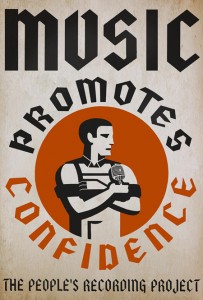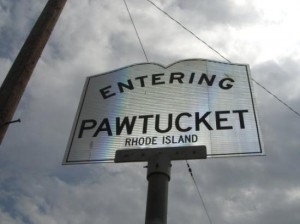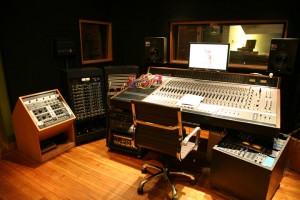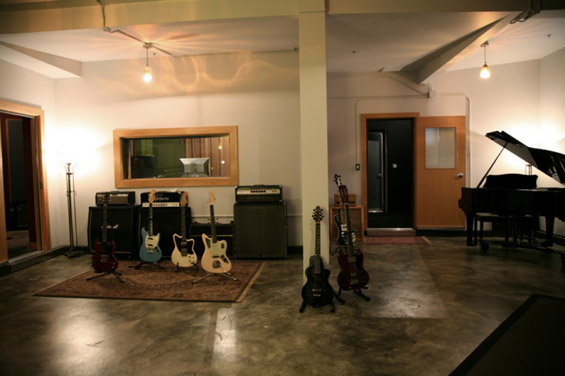Local Recording Scenes: Machines with Magnets Attracts NYC Musicians to Providence, RI
About 5 minutes outside of the center of Providence, Rhode Island, there’s an old industrial mill town called Pawtucket. If that name sounds familiar, chances are that it’s because you’ve heard it on the TV show Family Guy, which takes place in a fictionalized version of the area.
But as far as anything most people would call “culture” goes, that’s about all that Pawtucket had contributed to the outside world for a long time. Since the 1700s, its exports had mostly been “things” like textiles, iron, and later, toys, when Hasbro moved in to town.
To be fair, Pawtucket has been the birthplace of a couple of renowned musicians over the years. The early synthesizer pioneer Wendy Carlos and Americana guitarist David Rawlings come to mind, but both of them moved to New York City to find creative opportunities when they were getting started.
Today, that pattern is beginning to reverse.
The “SoHo Effect”
In 2004, The New York Times ran a story about an effort made by the town of Pawtucket to attract arts and artists into the community.
The old mills that had once contributed to a booming industrial revolution lay dormant and un-utilized.
The town’s board, looking south to New York City, eventually realized that these were exactly the kinds of buildings that had powered the wildly profitable waves of gentrification that had swept through NYC over the past four decades.
By then, there was clearly enough of a pattern to try and emulate:
Step 1: Artists move in, renovate, and give the place some class.
Step 2: A few pioneering businesses set up shop and make the area even more interesting.
Step 3: Developers start getting involved and pitch the neighborhood to an even better-heeled, second wave of gentrifiers.
Step 4: Everybody makes money, and hopefully, no one worth keeping around gets priced out.*
(*This is the Very Tricky Part.)
In the early 2000s, the plan worked pretty well. When the Times profile was written, Pawtucket was offering loans to restaurateurs to open trendy eateries; Architects and graphic designers from New York were moving into 7,500 square foot former shoe stores to live and work; And huge warehouses were being converted into enormous, airy lofts that sold briskly to young professionals who would commute to Boston.
In 2008, PBS showcased a feature-length documentary called Pawtucket Rising, chronicling the town’s transformation from dusty run-down mill town to “Rhode Island’s Creative Community.”
Things slowed down a bit in the great recession shortly thereafter, and property values dropped slightly, much like they did everywhere else, but by then, Pawtucket had already been transformed.
Machines with Magnets
In 2003 producers/engineers Keith Souza and Seth Manchester teamed up in Souza’s all-analog recording studio, which he called “Machines with Magnets”. It was based in East Providence, RI. Soon after, they hooked up with some backers, bought an old industrial building in nearby Pawtucket, and began transforming it into something bigger and more ambitious. This new and current version of Machines with Magnets opened in 2006.
The building houses not only a full-fledged recording studio, but an 800 square-foot art gallery and a 2,000 square-foot performance space, complete with a full bar, and wired up for 32 channels of live recording. Equipment onsite includes a 26-channel Neotek Elite console, API DSM 24 custom sidecar, Thermionic Cutlure Fat Bustard 12-channel valve mixer, an Otari 2″ machine, and a long list of effects, mics, and instruments. Both owners live onsite in their own lofty apartments.
“The studio supports the building for the most part,” says Seth Manchester.
“Shows make a little bit of money, but mostly it’s recording. I’d say it’s about 75% bands, and maybe 25% from film and voiceover work. That kind of sustains the whole building, unless you include the two living spaces which help cover the mortgage too.”
Yes, you read that correctly New Yorkers: There are places in the world where recording studios support less profitable businesses like bars and art galleries, rather than the other way around.
Of course like anything that sounds too good to be true, there’s a catch: As vibrant as the burgeoning local music scene may be, it’s not enough to keep the studio churning all by itself.
“It’s probably about 60% local, and maybe 40% bands from New York,” says Manchester. “We get a lot of bands from there. I think it’s because we’re a little bit of a getaway, and also that we’re cheaper than a lot of studios this size.”
Although New York City is about a 2.5 hour drive away, the sheer volume of musicians that live here (plus the staggering cost of real estate) conspire to make it so that clients from New York far outweigh those from Boston, which sits just 45 minutes to the northeast.
To date, Machines with Magnets has attracted a number of gritty and often un-categorizable bands from small labels like Thrill Jockey, Sub Pop, Warp, Luaka Bop, Western Vinyl and Load Records.
Recent artists include Battles, Lightning Bolt, The Body, Neptune, Clap Your Hands Say Yeah and Javelin.
The Value of a Scene
Throughout most of the 20th century live shows acted as a bit of a “loss leader” for the sale of recorded music.
The truth is that good live shows are expensive to put on, they don’t scale up very easily, and if you want them to make a respectable amount of money, the unfortunate reality is that you kind of have to charge a lot more than some of your audience might be able to pay.

Poster from a recent People’s Recording Project with The Silks.
At Machines with Magnets the tradeoffs are similar. They keep shows inexpensive and infrequent – Seth Manchester says they have about 8 each month – but they’re also invaluable. Shows help create a scene, without which their business and their town just wouldn’t be the same.
Sometimes the shows even lead directly to studio work:
“The Skull Defekts played a show here,” Manchester says, “and when they found our their next stop on the tour got canceled, they just decided to do an album here the next day. They recorded here for 15 hours straight the day after their show and released it on Thrill Jockey.”
Sometimes, concerts can even act as kind of live, in-person crowdfunding campaign. To that end, MWM has developed a program called “The People’s Recording Project” in which they use shows at the venue to help local musicians supplement the cost of their productions.
And sometimes, shows are just damn good fun that can help bring an entire community together:
“I think the biggest we ever had was Dan Deacon, two years ago,” says Manchester. “It was a huge crowd – almost over capacity maybe. People were really excited. It was pulling from every demographic in Providence, from the college kids to the people who’ve been living in this town forever.”
Regionalism Works
“There’s a lot of opportunity in a place like this,” Manchester says. Then with a friendly laugh, he takes a moment to remind me of Patti Smith’s advice to young artists in recent years. (Namely: “Don’t Come To New York.”)
But in Providence and Pawtucket, things feel different: “You can buy and develop something here,” he says. “You can have time to work on art, to do what you want to do, and make a living at it.”
It seems to be working for Machines with Magnets. Seth Manchester and Keith Souza are keeping busy with progressively bigger bands from bigger labels, all while staying affordable and finding novel ways to support artists from their local scene. They’re even attracting work that would have once stayed local to New York City.
If you’re in a band, considering affordable options outside of the biggest cities, perhaps MWM is the kind of place you should add to your list. And if you’re a New York-based producer or engineer worried about losing work to these out-of-state usurpers? Go with them. Consider bringing your New York know-how and connections to smaller markets and help them elevate what they do, even if it’s just on one project at a time.
There’s a lot that nearby cities can offer to each other. And, just as it is with building new and vibrant neighborhoods, it’s up to the artists to lead the way.
Justin Colletti is an audio engineer, educator and journalist.
Please note: When you buy products through links on this page, we may earn an affiliate commission.










Mark D
October 1, 2013 at 7:04 am (11 years ago)Awesome piece Justin! I live in the Providence area and there’s no shortage of artistic things going on around here. We have some of the best venues over here for indie bands – from the Met in Pawtucket to the newly reopened Columbus theater in Providence. There’s a certain magnetism to the area that attracts smaller artists – probably because of Providence being a smaller city sitting right between Boston and New York. Cost of living, etc. is much lower than in either city, and it’s so great reading about MWM doing well. Really makes me happy to live in a place like this.